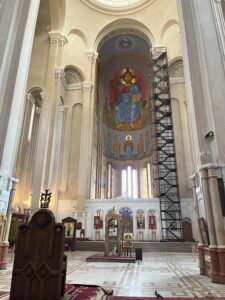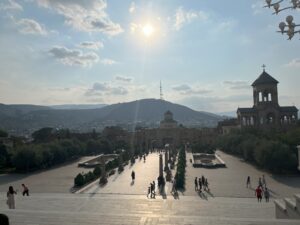If one has a clear view of the skyline in central Tbilisi, it’s hard to miss the towering figure of the Holy Trinity Cathedral. Better known locally as Sameba, the cathedral is an architectural marvel – the tallest church in Georgia and the third-tallest Eastern Orthodox church in the world. Today it is a symbol of Georgia’s post-Soviet national and religious revival. Lastly, it is also home to the Trinity Cathedral Choir, tasked by the Georgian Patriarch with preserving and promoting polyphonic singing, a unique art form with great importance to both religious and secular culture in Georgia. It is also a principal spiritual site as it contains the residence of the Patriarch of the Georgian Orthodox Church and a seminary to train priests.
Despite the significance of the cathedral, its history is recent.
History of Sameba Cathedral

Sameba was conceived in 1989 as the Georgian Orthodox Church was asserting itself more as part of Georgia’s opposition to the disintegrating Soviet Union. Aside from being a triumphant symbol of Georgian independence, Sameba was meant to commemorate 1,500 years of Christianity in Georgia and the 2,000-year anniversary of the birth of Jesus Christ. The chosen location was on top of Elia Hill in the Avlabari District, the former site of an Armenian Apostolic church and graveyard that had been mostly razed by the Soviet government in the 1930s. Many tombstones became construction material in local Soviet building projects. Controversially, many graves that had survived the Soviets were relocated by Georgian builders to make way for the church and the planned Friendship Park that is part of the church complex.
Due to the post-Soviet unrest in Georgia, construction of the cathedral only began in 1995. Sameba was completed in 2004 and eventually consecrated on November 23rd to coincide with Giorgoba (St. George’s Day), one of Georgia’s premier religious holidays.
The construction of Sameba was a significant feat. For one, no church in Georgian history had ever been to this scale, and the building of the cathedral occurred in a time of social, political, and economic instability. Furthermore, while the Georgian government under Presidents Eduard Shevardnadze and then Mikhail Saakashvili publicly supported the initiative, almost all of the funding came from private contributions. The construction of Sameba was personally requested and supervised by Patriarch Ilia II and was built according to the norms of Georgian and Byzantine architecture from the 10th and 11th centuries. While the building is complete, there is continuing work to adorn the walls with more iconography as evidenced by the scaffolding that remains in the interior today.
Visiting the Cathedral
Walking through the main gates of the complex, a visitor is immediately struck by the grandeur of the cathedral. The path leading up to the main staircase is flanked by a series of stone pillars with intricate designs chiseled into them with scenes of Georgian Christianity. When going up the stairs, people look like ants under the towering domes of Sameba.
The inside of the cathedral is a world of its own, and its space is so massive that birds fly in and easily roam. On the off hours, worshippers dot the grounds of Sameba, while priests lead different groups in prayer. Within the cathedral, there are multiple things to see. In addition to the many other beautiful icons, the Hope of Georgia icon stands out. It is located in a glass encasement near the front and is noticeable by its size and opulence, with over 30 kilograms of gold and jewels allegedly worth over 30 million dollars. Over 400 saints are depicted on the icon and it is a great example of the Georgian minankari (cloisonne enamel) style of iconography. It is also worth exploring the underground part of the cathedral that contains five of Sameba’s nine chapels and an ornate staircase.
Sameba’s territory additionally hosts gardens, fountains, and maintained shrubbery that can make for an excellent stroll. There is even a coop with ducks, chickens, and peacocks near the entrance. The premises offer one of the best views of downtown Tbilisi. Aside from gift and icon shops, the Sameba complex hosts an artisan children’s toy store, a furniture store, a sewing shop, and more. In addition, there are multiple sculptures of prominent Georgians and other monuments, including a stone with one of the first known inscriptions of modern Georgian and a structure containing a sixth-century cross.
It is also still possible to see the remnants of the territory’s Armenian cultural heritage, as up the hill behind Sameba sits the Armenian Pantheon with burials of prominent members of the city’s historic Armenian community who played an essential role in the physical and cultural development of Tbilisi. The Pantheon was originally opened in the 1960s after local efforts to preserve the most significant graves. The Pantheon was expanded with additional preserved gravestones during the construction of Sameba. Besides this, much of the Armenian history of Tbilisi has been erased.
Entrance to Sameba is free, but as a guest, it is important to be respectful by following local customs and dress codes listed on the signs at the front of every church. Every day there are matins and vespers services (morning and evening, respectively) with a small choir singing polyphonic chants. The two main weekly services are the Sunday Divine Liturgy around 10:00 A.M. and the Saturday vespers the preceding evening. The Trinity Cathedral Choir sometimes performs for the Divine Liturgy.
Sameba is a site of great importance in Tbilisi. A monumental site celebrating and expressing Georgian pride, it both recalls Georgia’s long past as an early cradle of Christianity and its struggles to break free of the USSR. Aside from being an impressive religious and architectural site, it offers many interesting sites to see including precious artifacts and ideal views of downtown Tbilisi. Sameba is an important expression of Georgian identity whose presence is seen from all over the city.
You’ll Also Love

Dictionary of Georgian Food
The following dictionary is devoted to Georgian cuisine. Known for its rich flavors, diverse ingredients, and unique culinary techniques, Georgian food becomes a favorite of nearly all who try it. It is also surprisingly healthy and, overall, vegetarian-friendly. Our curated entries below outline not only well-known favorites like khachapuri, but also lesser-known desserts, a selection […]

A Guide to Georgian Dairy Products
Georgian cuisine, known for its unique flavor combinations, is also known for several unique dairy products. Like similar dairy products around the world, these originated from the same need to preserve the nutritional and caloric value of milk. With several local twists to the preparation process, however, including the use of “spontaneous starters” – or […]

Georgian Holidays 2025: A Complete Guide
Georgian holidays strongly reflect the country’s unique traditions and its demographics. First, as more than 80% of Georgians identify with the Georgian Orthodox Church, the strong influence of the church can be felt in the preponderance of Orthodox holidays. Georgia also has several holidays celebrating its statehood and independence, which have been hard-won. We can […]

The Habits of Nuns in Catholic and Orthodox Traditions
Despite their cloistered livelihood, nuns have found their way into many veins of popular theater and movies. However, their usual depiction, wearing black habits with a veil and carrying a rosary, is not accurate for all nuns. It is true that the symbolic meaning of the habit is consistent across both Catholic and Eastern Orthodox […]

Georgian Nutrition: A Tasty Way to Good Health
As a nutritionist, food is often the driving factor of my travels. I love exploring the local and traditional cuisines which help shape the identity of a country. Georgian culture is strongly influenced by, and perhaps best known for, its unique and vibrant cuisine. Georgian cuisine in Georgia is packed with fresh and organic produce […]











